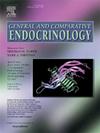温度调节17β-雌二醇对广温鱼肝脏产卵蛋白表达的调节
IF 1.7
3区 医学
Q3 ENDOCRINOLOGY & METABOLISM
引用次数: 0
摘要
雌鱼在卵子生成过程中,如果温度异常升高或持续时间过长,会导致卵母细胞发育受损,卵子数量减少或变小,卵黄含量降低或包膜变薄,卵子活力降低。卵母细胞质量和数量发生这些变化的部分原因是,在异常高温条件下,肝脏合成的卵黄蛋白(卵黄素,Vtg)和卵包膜蛋白(绒毛膜促性腺激素)减少。肝脏 Vtg 和绒毛膜促性腺激素产量的下降通常与血液中 17β-雌二醇(E2)浓度的降低同时发生。然而,目前还不清楚在高温条件下肝脏卵黄原素和绒毛膜促性腺激素产量的下降是否仅仅是由于循环中的 E2 降低所致,还是 E2 信号的其他方面也发生了改变,从而减少了肝脏对卵生成蛋白的合成。在这项研究中,将卵泡发育不同步的成年雌性阿玛戈萨河幼鱼(Cyprinodon nevadensis amargosae)分别饲养在 20 °C、28 °C或 36 °C,然后给它们注射 E2 或车辆溶液。与温度较低的雌性相比,36 °C下雌性的卵巢性腺指数(GSI)值和血浆E2都较低。36 °C雌鼠的血浆Vtg蛋白含量也有所降低,肝脏中编码卵黄素基因(vtgAa、vtgAb、vtgc)、绒毛膜促性腺激素基因(cgh、cghm、cgl)和雌激素受体α(esr1)的mRNA丰度也较低。补充 E2 增加了所有温度下雌性的血浆 E2,但只上调了 36 °C下肝脏的卵黄原素和绒毛原素 mRNA,尽管 E2 上调了所有温度下肝脏 esr1 受体的转录物。36 °C下的雌性动物肝脏中性激素结合球蛋白(shbg)和细胞色素P450家族1亚家族A成员1(cyp1a1)的mRNA丰度也较高,细胞色素P450家族1亚家族A成员1是一种雌激素代谢单氧化酶,可将E2转化为2-羟基雌二醇。这些研究结果表明,温度升高会影响 E2 信号的多个方面,包括循环 E2 浓度、肝脏 esr1 表达以及 shbg 和 cyp1a1 表达,从而减少 E2 对幼鱼肝脏 Vtg 和绒毛膜促性腺激素表达的刺激,这可能会导致游离:结合 E2 的变化以及肝脏 E2 失活的速度。这些结果还表明,E2替代物有助于补偿高温引起的雌性幼鱼肝脏卵子生成基因表达的下降。本文章由计算机程序翻译,如有差异,请以英文原文为准。
Temperature modulates 17β-estradiol regulation of oogenesis protein expression in the liver of the eurythermal pupfish Cyprinodon nevadensis
Female fish experiencing atypically high or prolonged elevations in temperature during oogenesis can suffer impaired oocyte development with fewer or smaller eggs, eggs with reduced yolk content or thinner envelopes, and lower egg viability. These changes in oocyte quality and quantity are in part caused by diminished liver synthesis of egg yolk (vitellogenin, Vtg) and egg envelope (choriogenin) proteins at anomalously high temperatures. Those declines in liver Vtg and choriogenin production are commonly paralleled by reduced blood concentrations of 17β-estradiol (E2). However, it is unclear whether declines in liver vitellogenin and choriogenin production at elevated temperatures result solely from lower circulating E2 or if other aspects of E2 signaling are also altered to diminish liver synthesis of oogenesis proteins. In this study, adult female Amargosa River pupfish (Cyprinodon nevadensis amargosae), a species with asynchronous follicular development, were maintained at 20 °C, 28 °C, or 36 °C and then administered E2 or vehicle solution. Ovarian gonadosomatic index (GSI) values and plasma E2 were lower in females at 36 °C compared to those at cooler temperatures. Females at 36 °C also had reduced plasma Vtg protein, lower liver abundances for mRNAs encoding vitellogenin genes (vtgAa, vtgAb, vtgc), choriogenin genes (cgh, cghm, cgl), and estrogen receptor α (esr1). Supplemental E2 increased plasma E2 in females at all temperatures, but only upregulated liver vitellogenin and choriogenin mRNAs at 36 °C, despite E2 upregulation of hepatic esr1 receptor transcripts at all temperatures. Females at 36 °C also exhibited higher liver mRNA abundances for sex hormone-binding globulin (shbg) and cytochrome P450 family 1 subfamily A member 1 (cyp1a1), an estrogen-metabolizing monooxygenase enzyme that converts E2 to 2-hydroxyestradiol. Together, these findings indicate elevated temperatures diminish E2 stimulation of liver Vtg and choriogenin expression in pupfish via effects on several aspects of E2 signaling including circulating E2 concentrations and liver esr1 expression as well as shbg and cyp1a1 expression, which may result in changes to free:bound E2 and the rate of hepatic E2 inactivation. These results also demonstrate that E2 replacement can help compensate for high temperature-induced declines in hepatic oogenesis gene expression in female pupfish.
求助全文
通过发布文献求助,成功后即可免费获取论文全文。
去求助
来源期刊

General and comparative endocrinology
医学-内分泌学与代谢
CiteScore
5.60
自引率
7.40%
发文量
120
审稿时长
2 months
期刊介绍:
General and Comparative Endocrinology publishes articles concerned with the many complexities of vertebrate and invertebrate endocrine systems at the sub-molecular, molecular, cellular and organismal levels of analysis.
 求助内容:
求助内容: 应助结果提醒方式:
应助结果提醒方式:


